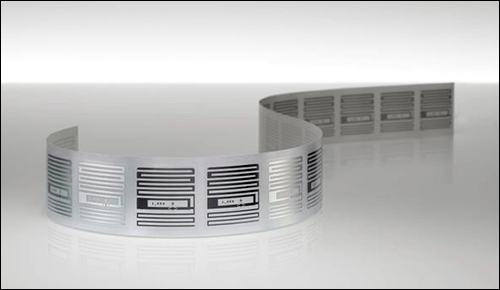- Avery Dennison Smartrac Unveils Inlays for Inventory, Supply Chain
- Renesas MCUs Achieve NIST CAVP Certification, Provide IoT Security
- Vubiq Networks Awarded Fifth RFID Technology Patent
- BOS’s RFID Division Receives Israeli Defense Order
Presented here are recent news announcements in the radio frequency identification and Internet of Things industries.
Avery Dennison Smartrac Unveils Inlays for Inventory, Supply Chain
Avery Dennison Smartrac has announced that its AD Twist U7XM inlays are suitable for inventory and supply chain management applications in challenging environments, such as automotive, aerospace and other industrial sectors. According to the company, its new UHF RFID inlays have been designed for environments in which metal is in situ to an inlay, such as within pipes, tubes and cable harnesses.

Avery Dennison Smartrac’s AD Twist U7XM inlays
The AD Twist U7XM, designed to meet the requirements of industry bodies such as the German Association of the Automotive Industry, features a form factor of 27 millimeters by 27 millimeters (1.063 inches by 1.063 inches), making it suitable for conversion into a loop-tag format. This creates flexibility in terms of the range of asset sizes and materials that can be tagged, the company explains, and the inlay provides a long, stable read range in close-to-metal applications.
“The AD Twist U7XM is a global product supporting FCC and ETSI frequencies, designed for any demanding industrial environment where metal is a factor,” said Lauri Hyytinen, Avery Dennison Smartrac’s market-development manager for automotive, in a prepared statement. “It can be used to tag cables, tubes and wires or other applications where attaching a standard UHF RFID inlay on the surface of an item has previously been a challenge. We see it as being particularly suitable for the rapidly expanding production of electric vehicles, and it ships with 448-bit EPC and 2,048-bit user memory, which means it meets the requirements of VDA and other industry associations globally.”
Available now, the AD Twist U7XM features NXP‘s UCODE 7XM IC with extended memory, supporting 2 kilobits of user memory. This, according to the company, makes it suitable for applications requiring extended user memory to store data specific to products, with brand protection via digital signature. A read distance of 4 to 6 meters over both FCC and ETSI frequency areas supports a range of use cases. The inlays are halogen-free and comply with the ISO 9001:2015 Quality Management and ISO 14001:2015 Environmental Management standards.
Renesas MCUs Achieve NIST CAVP Certification, Provide IoT Security
Renesas Electronics, a supplier of semiconductor solutions, has announced that the security engine of its RA Family of 32-bit Arm Cortex-M microcontrollers (MCUs) has been certified by the National Institute of Standards and Technology (NIST)’s Cryptographic Algorithm Verification Program (CAVP). Drivers to utilize the certified SCE9 Protected Mode are included in the RA Family Flexible Software Package v3.6.0 and later.
The company’s RA6M4, RA6M5, RA4M2 and RA4M3 MCU Groups all received NIST CAVP certification for a suite of cryptographic algorithms, including multiple modes of Advanced Encryption Standard, hashing, Rivest Shamir Adleman and Elliptic Curve Cryptography key generation and authentication, as well as Key Agreement Schemes and Deterministic Random Bit Generator. NIST CAVP certification provides independent verification of the correct implementation of such algorithms, ensuring connectivity interoperability. Renesas announced last year that its RA devices received both PSA Certified Level 2 and Security Evaluation Standard for Internet of Things (IoT) platform certifications.

Renesas’s MCUs have been CAVP-certified.
“With CAVP certification, in conjunction with the existing SESIP1 and PSA Certified Level 2, Renesas provides the industry’s most comprehensive IoT security solutions,” said Roger Wendelken, the senior VP of Renesas’s IoT and Infrastructure Business Unit, in a prepared statement. “Customers in a broad range of connected application segments can implement the RA family with supreme confidence that their data will be secure.”
An integrated security architecture provides unlimited key storage, and an independent evaluation recently compared SCE9 Protected Mode operation to a selection of secure elements. “The SCE9 doesn’t just pack a significant amount of cryptographic compute power, but getting rid of a serial interface (usually I2C) to an externally connected device provides various advantages,” added Mario Noseda, from Zurich University of Applied Sciences’ School of Engineering, in the prepared statement. “The high clock frequency of the internal data bus greatly reduces the data transmission time between the MCU and the SCE9. But even more important is the complete elimination of a point of attack, which is a huge selling point for an MCU containing the SCE9.”
The Security Key Management Tool provides a mechanism for preparing keys for secure installation and updates, supporting development, production provisioning and key updates for products in the field. The GUI interface is designed to assist developers, particularly those new to security solutions, to create prototypes and proofs-of concept with test keys. The command line interface coordinates across multiple developers and supports production key management of key provisioning and update. Downloadable Application Projects demonstrate how to perform secure key installation and updates for both development and production using the available Renesas tools.
According to Renesas, the MCUs provide IoT security by combining Secure Crypto Engine IP with NIST CAVP certifications on top of Arm TrustZone for Armv8-M. RA devices incorporate hardware-based security features, ranging from simple AES acceleration to fully integrated crypto subsystems isolated within the MCU. The Secure Crypto Engine provides symmetric and asymmetric encryption and decryption, hash functions, true random number generation, and key handling, including key generation and MCU-unique key wrapping.
Vubiq Networks Awarded Fifth RFID Patent
Vubiq Networks, a provider of millimeter-wave wireless broadband solutions, has been awarded its fifth radio frequency identification patent by the U.S. Patent and Trademark Office. Patent #11288468, titled “Multimode Millimeter Wave RFID Systems and Methods of Use Thereof,” expands and protects Vubiq Networks’ RFID hyperimaging technology. It describes a new reader design that performs wide-beam polarimetric synthetic aperture radar (POLSAR), narrow beam reads from chipped tags, and narrow-beam reads and communications with chipped tag and IoT devices.
“This new patent is a continuation of our previous multimode RFID patent and includes additional claims,” said Mike Pettus, Vubiq Networks’ founder and CTO, in a prepared statement. “The new patent has an independent method claim describing a computing device which controls the RFID reader, a second independent system claim describing an RFID control computing device which controls the reader, and a third independent system claim describing a non-transitory, computer-readable medium having stored instructions for operating the RFID reader.”
The multimode patent adds new claims concerning a computing device and non-transitory, computer-readable media that controls the RFID technology, and it also broadens the patent’s coverage, the company reports. Vubiq Networks’ RFID patent portfolio covers its data-encoding technology that exploits the physics of antennas at a small scale. The result, according to the firm, is a chipless RFID data tag that approaches the cost of printing a bar code, but with the ability to contain hundreds of data bits in the size of a postage stamp.
BOS’s RFID Division Receives Israeli Defense Order
BOS Better Online Solutions has announced that its RFID Division has received an order valued at $330,000 from a customer in the Israeli defense industry. “This is a significant order for warehouse-management software and mobile equipment for tracing inventory,” said Uzi Parizat, the VP of sales and marketing within BOS’s RFID Division, in a prepared statement. “The order is for delivery through the year 2023.”
BOS provides services and systems for inventory production and management in three channels: services, integration and development. Its Supply Chain division provides inventory procurement and kitting. Its RFID Division provides off-the-shelf software and equipment to track and manage inventory in the production floor and warehouse. And its Intelligent Robotics Division develops and builds custom-made robotic cells for the industrial and logistic processes.
“I am very pleased that this customer of our Supply Chain Division has now placed an order with our RFID Division,” added Eyal Cohen, BOS’s CEO, in the prepared statement. “In the future, we hope to be able to provide this customer also with the customized robotic systems of our Intelligent Robotics Division.”


